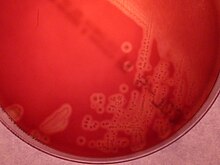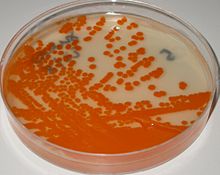
Back عقدية قاطعة للدر Arabic عقديه قاطعه للدر ARZ Streptococcus agalactiae Catalan Streptococcus agalactiae German Streptococcus agalactiae Spanish استرپتوکوک آگالاکتیه Persian Streptococcus agalactiae Finnish Streptococcus agalactiae French Streptococcus agalactiae Galician Streptococcus agalactiae Hungarian
| Streptococcus agalactiae | |
|---|---|

| |
| Scientific classification | |
| Domain: | Bacteria |
| Phylum: | Bacillota |
| Class: | Bacilli |
| Order: | Lactobacillales |
| Family: | Streptococcaceae |
| Genus: | Streptococcus |
| Species: | S. agalactiae
|
| Binomial name | |
| Streptococcus agalactiae Lehmann and Neumann, 1896
| |
Streptococcus agalactiae (also known as group B streptococcus or GBS) is a gram-positive coccus (round bacterium) with a tendency to form chains (as reflected by the genus name Streptococcus). It is a beta-hemolytic, catalase-negative, and facultative anaerobe.[1][2]
S. agalactiae is the most common human pathogen of streptococci belonging to group B of the Rebecca Lancefield classification of streptococci. GBS are surrounded by a bacterial capsule composed of polysaccharides (exopolysacharide). The species is subclassified into ten serotypes (Ia, Ib, II–IX) depending on the immunologic reactivity of their polysaccharide capsule.[1][3][4]
The plural term group B streptococci (referring to the serotypes) and the singular term group B streptococcus (referring to the single species) are both commonly used synonymously with S. agalactiae even though S. halichoeri and S. pseudoporcinus are also group B Streptococci. These species test positive as group B, but are not frequently carried by humans, and only rarely cause disease.[5]
In general, GBS is a harmless commensal bacterium being part of the human microbiota colonizing the gastrointestinal and genitourinary tract of up to 30% of healthy human adults (asymptomatic carriers). Nevertheless, GBS can cause severe invasive infections especially in newborns, the elderly, and people with compromised immune systems.[6]

S. agalactiae is also a common veterinary pathogen, because it can cause bovine mastitis (inflammation of the udder) in dairy cows. The species name agalactiae meaning "of no milk", alludes to this.[7]




- ^ a b Whiley RA, Hardie JM (2009). Genus I. Streptococcus Rosenbach 1884. Bergey's Manual of Systematic Bacteriology: Vol 3: The Firmicutes (2nd ed.). Springer. pp. 655–711. ISBN 978-0-387-95041-9.
- ^ Ryan KJ, Ray CG, et al., eds. (2004). Sherris Medical Microbiology (4th ed.). McGraw Hill. pp. 286–8. ISBN 978-0-8385-8529-0.
- ^ Edwards MS, Nizet V (2011). Group B streptococcal infections. Infectious Diseases of the Fetus and Newborn Infant (7th ed.). Elsevier. pp. 419–469. ISBN 978-0-443-06839-3.
- ^ Slotved HC, Kong F, Lambertsen L, Sauer S, Gilbert GL (2007). "Serotype IX, a proposed new Streptococcus agalactiae serotype". J Clin Microbiol. 45 (9): 2929–2936. doi:10.1128/jcm.00117-07. PMC 2045254. PMID 17634306.
- ^ "Guidelines for the Detection and Identification of Group B Streptococcus" (PDF). The American Society for Microbiology. July 23, 2021.
- ^ Cite error: The named reference
Edwards-Baker-Mandellwas invoked but never defined (see the help page). - ^ Cite error: The named reference
Keefe1997was invoked but never defined (see the help page).